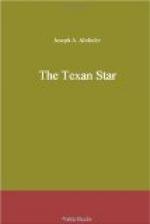The next day they drew near to San Antonio and entered the beautiful valley made by the San Antonio River and the creek to which the Mexicans gave the name San Pedro. Ned found it all very luxuriant and very refreshing to eyes tired of the prairies and the plains. Despite the fact that it was the middle of October the green yet endured in that southern latitude. Splendid forests still in foliage bounded both creek and river. They rode through noble groves of oak and tall pecans. They saw many fine springs spouting from the earth, and emptying into river and creek.
It was a noble land, but, although it had been settled long by Spaniard and Mexican, the wilderness still endured in many of its aspects. Now and then a deer sprang up from the thickets, and the wild turkeys still roosted in the trees. Churches and other buildings, many of massive stone adorned with carved and costly marbles, extended ten or twelve miles down the river, but most of them were abandoned and in decay. The Comanche and his savage brother, the Apache, had raided to the very gates of San Antonio. The deep irrigation ditches, dug by the Spanish priests and their Indian converts, were abandoned, and mud and refuse were fast filling them up. Already an old civilization, sunk in decay, was ready to give place to another, rude and raw, but full of youth and vigor.
It was likely that Ned alone felt these truths, as they reached the lowest outskirts of the missions, and stopped at an abandoned stone convent, built at the very edge of the San Antonio, where the waters of the river, green and clear, flowed between banks clothed in a deep and luxuriant foliage. Half of the troop entered the convent, while the others watched on the horses outside. It impressed Ned with a sense of desolation fully equal to that of the ancient pyramid or the lost city. Everything of value that the nuns had not taken away had been stripped from the place by Comanche, Apache or Lipan.
It was nearly night when they arrived at the convent. The Texan camp still lay some miles away, their horses were very tired, and Bowie decided to remain in the ruined building until morning. The main portion of the structure was of stone, two stories high, but there were some extensions of wood, from one of which the floor had been taken away by plunderers. It was Ned who discovered this floorless room and he suggested that they lead the horses into it, especially as the night was turning quite cold, and there were signs of rain.
“A good thought,” said Bowie. “We’ll do it.”
The horses made some trouble at the door, but when they were finally driven in, and unsaddled and unbridled they seemed content. Two windows, from which the glass was long since gone, admitted an abundance of air, and Ned and several others, taking their big bowie knives, went out to cut grass for them.
On foot, Ned was impressed more than ever by the desolation and loneliness of the place. The grounds had been surrounded by an adobe wall, now broken through in many places. On one side had been a little flower garden, and on the other a larger kitchen garden. One or two late roses bloomed in the flower garden, but most of it had been destroyed by weather.




